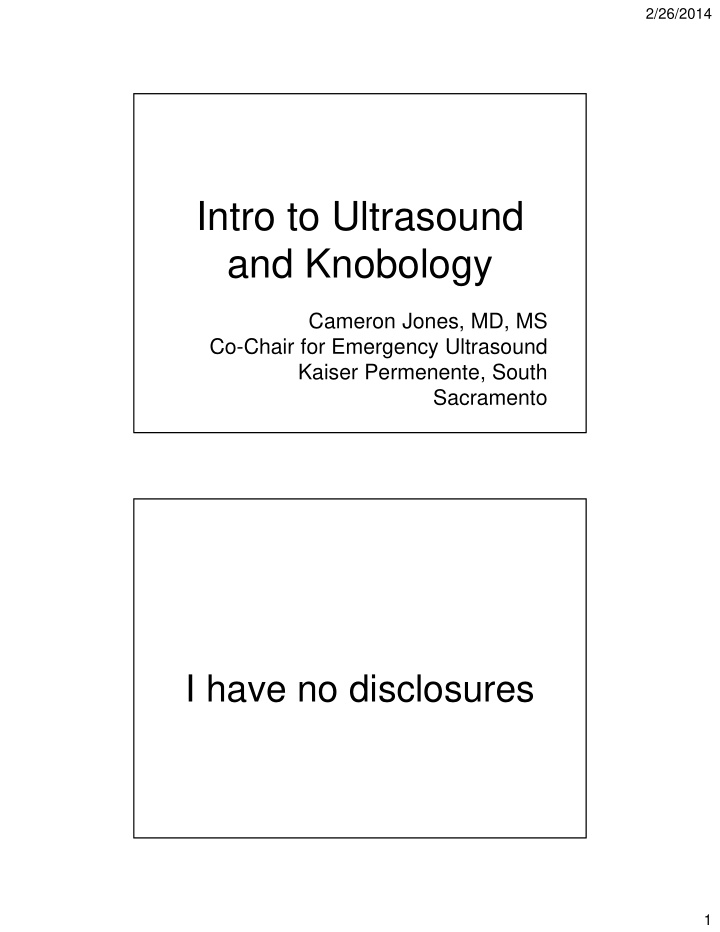



2/26/2014 Intro to Ultrasound and Knobology Cameron Jones, MD, MS Co-Chair for Emergency Ultrasound Kaiser Permenente, South Sacramento I have no disclosures 1
2/26/2014 SOUND : Series of pressure waves traveling through a medium • Physics Words • WAVELENGTH : Distance traveled in one cycle • FREQUENCY : number of cycles per sec (Hertz) “Fancy” Words • PIEZOELECTRIC EFFECT : crystals vibrate at a given frequency when an alternating current is applied • PULSE-ECHO MODE : signal generation <1% of pulse cycle 2
2/26/2014 ATTENUATION: Reduction of intensity and amplitude • Absorption : Most common, creates heat • Reflection : “Echo” • Scattering : non-homogeneous surface • Refraction : Different densities Ultrasound Modes Brightness Mode: Different shades of gray 3
2/26/2014 Transducers (aka: Probes) Increasing frequency improves resolution at the expense of penetration Resolution: Ability to delineate between 2 different objects Lateral Axial Resolution: Resolution: The ability to separate Ability to separate 2 objects linear to the structures side by ultrasound beam side 4
2/26/2014 Transducer basics Convex Array : Sector Scanning - Resolution becomes poorer at greater depths Transducer basics Phased Array : Flat Head, crystals fire at variable time 5
2/26/2014 Transducer basics Linear Array Echogenicity • Hypoechoic • Less echogenic than • Hyperechoic surrounding tissue • More echogenic • Very few echo ’ s, than surrounding appears darker tissue • • Object has lots of Anechoic / Echolucent • echo’s, appears Absence of returning echo ’ s brighter • Area is black 6
2/26/2014 Probe Position and Image Orientation • In relation to probe dot • Transverse • Longitudinal • Coronal / Sagittal Button Basics • Gain • Strength of returning echoes • Amplifier • Gain is adjusted differently depending on the machine 7
2/26/2014 Artifacts: Attenuation Artifacts • Shadowing • Partial or total reflection of sound • Weak or no transmission posterior Artifacts: Attenuation Artifacts • Posterior Enhancement • Area behind echo- weak or echo-free structure appears brighter 8
2/26/2014 Artifacts: Attenuation Artifacts • Edge Artifact aka “ Side Lobe ” • Sound waves are scattered when they encounter cystic wall or curved surface • Energy loss Artifacts: Propagation Artifacts • Reverberation • Sound encounters 2 highly reflective layers • Sound is bounced back and forth • Probe detects a longer traveling time 9
2/26/2014 Artifacts: Propagation Artifacts • Mirror Imaging • Sound glances off Liver highly reflective surface (diaphragm) • Returning sound waves have longer travel time • Misinterpretation of Mirror Diaphragm “ more liver ” Artifacts: Mirror Image Liver Mirror Diaphragm 10
2/26/2014 Artifacts: Mirror Image Liver No Mirror Diaphragm Trouble-Shooting Know your anatomy Define boundaries Choose the proper transducer Learn acoustic windows Go from wider view and zoom in Visualize the anatomy in two planes Maximize system controls - depth/gain/frequency 11
2/26/2014 Image Acquisition Tips • “ I am having a hard time finding _____, do you have any tips? ” • Use more gel! • Transducer movements • F an • A ngle • R otate • T ranslocate / T ry a new location (window) Only try one movement at a time 12
Recommend
More recommend